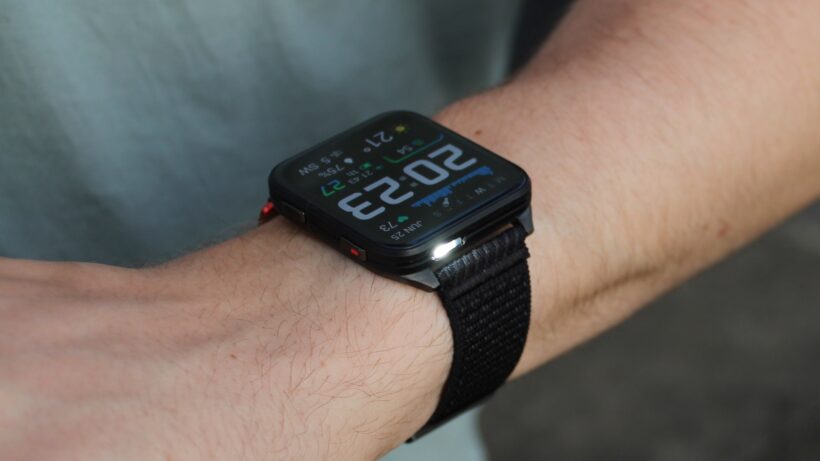A feature-packed sports watch in ultra-thin smartwatch clothing
The Venu X1 brings Garmin's smartwatch journey full circle, delivering a modern take on the super-slim, square-case concept first introduced with the original Vivoactive. The design is a triumph; it's the best-looking and most comfortable smartwatch Garmin has ever made, with a stunning AMOLED display to match. However, the aesthetic finesse comes at the cost of the brand's own modern hallmarks. Legendary battery life is slashed to just two days with AOD enabled, and the absence of Multi-Band GPS and ECG feels like a sacrifice too far for the price. The lack of a defining smart feature—such as a revival of Garmin's take on LTE—also holds it back from truly competing with the industry's 'Ultra' watches. Ultimately, the Venu X1 is a statement piece for the dedicated Garmin user who prioritizes form over all, but one that feels compromised.
Pros
- Incredibly thin, light, and comfortable design
- Core sports tracking accuracy is outstanding
- An LED flashlight—in this design!
Cons
- Two-day AOD battery life
- No ECG or dual-frequency GPS
- No killer smart feature (like LTE) to differentiate it
When the Garmin Venu X1 was announced, the narrative wrote itself: this was Garmin, the rugged sports watch giant, finally making a direct play for the premium, design-led smartwatch space dominated by Apple and Samsung.
While that’s true, there’s a more compelling story with the Venu X1 than simply Garmin battling its rivals. Instead, this is really Garmin looking back. Rather than being a mere ploy to capture the ‘Ultra’ market, it’s an idea that has been a decade in the making, beginning with the original Vivoactive.
Like the Venu X1, the OG Vivoactive was an incredibly thin, square-faced device; it was the brand’s first serious attempt at a smartwatch. The Venu X1 is based on the same concept, but updated for the modern smartwatch world.
With the Venu line having long since taken the reins from the Vivoactive as Garmin’s premier smartwatch-style family, the X1 arrives as the pinnacle of that evolution: a powerful sports watch wrapped in a package that prioritizes aesthetics and all-day comfort above all else.
It’s a device that gets so much right, but that ambitious, stellar design is also the result of some significant (and, at times, baffling) compromises. Below is our extended take.
Price and competition
At $799/£679, the Venu X1 plants its flag firmly in premium territory. This isn’t just another expensive Garmin; it’s priced to make you choose between it and the best from Apple, Samsung, and Google.
However, comparing it directly to those brands’ smart features would be to miss the point. As we always say, if you want a ‘proper’ smartwatch, with a sprawling app ecosystem and seamless phone integration, you’re not going to find that with Garmin.
The Venu X1 is for a different buyer: the person who is committed to the Garmin ecosystem but has long been envious of the sleek designs emerging from Cupertino. Its real competition, therefore, comes from within.
For less money, you could get a Garmin Forerunner 970. For slightly more, a Garmin Fenix 8. Both of these options offer more features for the hardcore athlete, including longer battery life and, crucially, the option to utilize Garmin’s class-leading Multi-Band GPS.
The choice to buy the Venu X1 is an explicit decision to trade some of that top-tier performance for a design that you’ll want to wear 24/7, from the trail to the office.
SQUIRREL_PLAYLIST_10207701
Design and display




For the avoidance of any doubt: the design is the main reason to buy this watch.
At just 7.9mm thick and weighing a barely-there 40g, the Venu X1 is a marvel of smartwatch engineering. Picking it up after wearing a Fenix is a night-and-day difference. It’s a real factor in wanting to put it on over my current long-term test unit, the Forerunner 970, which itself is no heavyweight. The thinness isn’t a gimmick, either; it’s a transformative feature that makes it supremely comfortable for all-day wear and, importantly, for sleeping with.
The materials also feel every bit as premium as the price tag suggests, with the titanium case proving remarkably durable. While the titanium bezel on my Forerunner 970 is already covered in scratches from daily wear, the Venu X1’s case has remained pristine, even after being unceremoniously tossed into a bag full of charging cables and other gadgets during my travels.
The star of the show is the 2-inch AMOLED display, protected by sapphire crystal. It’s excellent—super vibrant, incredibly bright, and far more in line with what you’d expect from an Apple Watch. It makes Garmin’s software, which can still sometimes feel a bit dated and slow to react, feel modern and fluid.

The small dead spot at the top of the screen (likely there to house the flashlight and other sensors) is a minor blemish on its record, but the display is so expansive that you barely notice it.
Flashlight FTW!
Speaking of the flashlight, it’s another top addition inherited from the Fenix and the latest top-end Forerunner. While technically less bright than the ones on the Fenix 8 or 970, the difference is negligible in practice.
As I’ve mentioned previously (read: every time I review a Garmin with this feature), it’s infinitely more useful than your phone’s flashlight because it’s always on your wrist, ready to go. I use it every single day, and can’t believe more sports watch brands don’t include it on their outdoor watches. Having it even on a faux smartwatch like the X1 feels like a real luxury.
However, the transition to a more minimalist design has brought some ergonomic quirks. As a long-time Garmin user, I’m hardwired for the five-button control system. The X1’s two-button-plus-touchscreen setup took me a while to get my head around, and I still find myself reaching for a phantom ‘back’ button.
I can’t help but feel it could really do with just one more button on the left side of the case to make navigation that little bit more intuitive—especially during a workout.
Sports tracking and accuracy

For all its smartwatch pretensions, the Venu X1 is a Garmin through and through when it comes to tracking. It has a dizzying array of sports profiles and inherited the full suite of advanced training metrics from its more serious brethren, including Training Readiness, Endurance Score, and Hill Score.
A post-launch update even brought over the Forerunner 970’s exclusive running metrics, such as Running Economy and Impact Load, which is also perhaps a promising sign that this Venu won’t be left behind on software updates (like other models in this line historically have been in comparison to the Fenix/Forerunner devices).
But there are some properly strange omissions here—likely sacrifices made at the altar of thinness.
The most significant is the lack of Multi-Band GPS. This effectively rules the Venu X1 out as a serious option for marathoners who demand pinpoint accuracy in tricky urban environments, or trail runners who spend time under dense tree cover. There’s no SatIQ either, Garmin’s clever tech that dynamically switches GPS modes to save battery.
Tracking performance: GPS and heart rate data
That said, for most conditions, the standard GPS is still exceptional. In five example test runs in relatively open areas, the Venu X1 was, at most, 0.01 miles off the track laid down by the Multi-Band-toting Forerunner 970 on each run. This proves that Garmin’s baseline GPS is still superior to many rivals’ best efforts.


Heart rate accuracy from the Elevate Gen 5 sensor is similarly strong. In a tough interval session (below), it lagged slightly behind the connected Garmin HRM 600 chest strap (as all optical sensors do), but still managed to capture the same maximum heart rate of 183 BPM (and was only 1 BPM off on the average).
In a more stable, base-pace run (above), the story was the same. It’s a very good showing.


The mapping experience is also superb, elevated by that big, bright display. But here again, a compromise rears its head. The battery drain from using maps makes taking the Venu X1 on an all-day hike a slightly nerve-wracking proposition compared to the Fenix 8.
And with a water resistance rating of just 50 meters—the same as a Forerunner, not the 100m of a Fenix—it doesn’t quite have the ‘Ultra’ credentials for serious water sports enthusiasts.
Health and smart features

On the health and smarts front, the Venu X1 has all of Garmin’s greatest hits, but it’s missing a headline act. The omission of an ECG sensor seems very strange for a watch of this price in 2025.
To be clear, I don’t personally find ECG particularly useful in my day-to-day life, and if its removal helped achieve this design, I’d consider it a worthy trade-off. From a market perspective, however, it’s still an expected feature.
When it comes to smarts, the story is a familiar one for Garmin. The experience is good for a sports watch, but it’s not a ‘true’ smartwatch. You get offline Spotify support, a microphone and speaker for calls (which is louder here than on other Garmin devices), and 32GB of storage.

However, Garmin is still miles off from providing the deep integration and vast app libraries of Apple and Google. Notifications are basic, and there’s no sense of the watch acting as a seamless second screen for your phone.
This device is crying out for a killer new smart feature, and the strongly-rumored revival of Garmin’s LTE support would have been a perfect fit.
A cellular-packing Venu X1 would have been a huge differentiator from the Forerunner and Fenix lines and a genuine draw for the premium smartwatch crowd—especially as the industry’s key trending new feature in 2025 (as seen on the Pixel Watch 4, and rumored to be arriving on the next-gen Apple Watch devices) is safety features provided by satellite cellular connectivity. Alas, it wasn’t to be.
Battery life
And now, for the Venu X1’s Achilles’ heel: the battery life. Garmin has built its reputation on longevity, but the Venu X1 makes a drastic departure from that legacy.
With the always-on display enabled—which you’ll want to use because it looks fantastic—I consistently got just two days of battery life. That is a deeply un-Garmin-like number.
It’s a real killer, and probably the biggest reason I’d hesitate to choose it (or recommend it) over the Forerunner 970, which gives me four-ish days of staying power under the same conditions.
This feels like one compromise too many in the quest for thinness. I would have happily accepted a slightly thicker case to double the battery life. And for a brand that champions a battery-first philosophy, this feels like a step in the opposite direction, forcing users into the near-nightly charging routine that many choose Garmin to escape.
Summary: Should you buy the Garmin Venu X1?




The Garmin Venu X1 is a beautiful, frustrating, and ultimately fascinating device. It’s undoubtedly the most attractive and comfortable smartwatch Garmin has ever produced, boasting a design and display that are truly top-tier. However, it remains a device characterized by its compromises.
It sacrifices the battery life and class-leading GPS accuracy that Garmin purists cherish, yet it doesn’t fully deliver the seamless smart experience that would convert an Apple Watch user.
It exists in a stylish, sporty middle ground.
This isn’t Garmin’s Apple Watch Ultra killer—it’s a Garmin for people who have always wanted one but couldn’t get on with the rugged design.
It’s a sports watch in a beautiful disguise. And for a particular type of user, it will be nearly perfect. Yet, for those at either end of the spectrum—the hardcore athlete or the smartwatch power user—its compromises may be a step too far.





